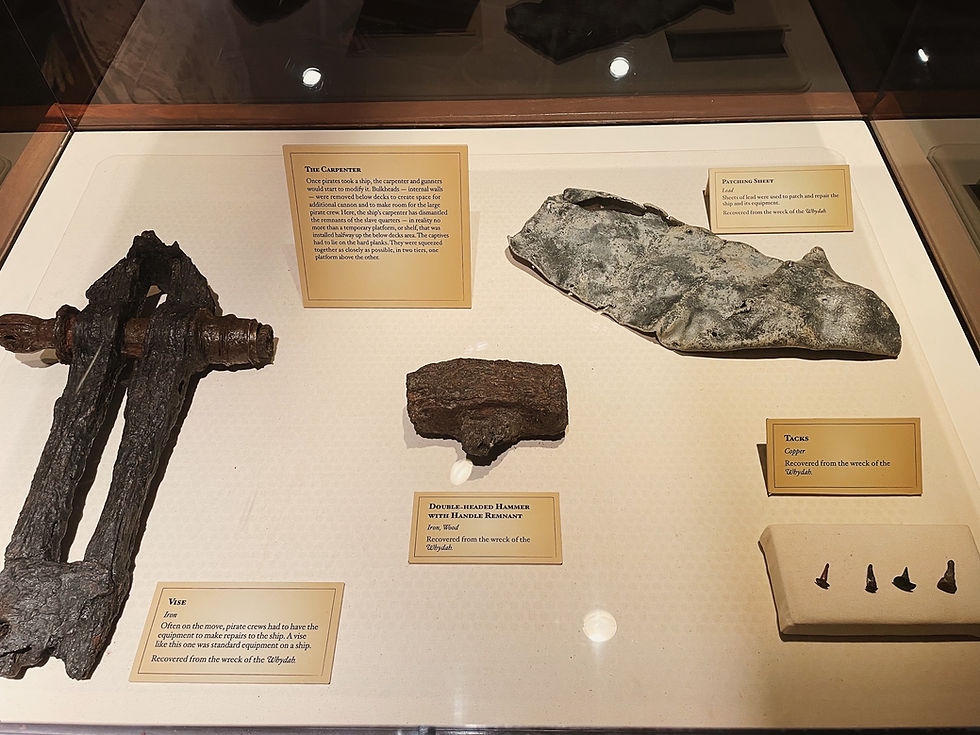Wooden Water Pipes
- marcsitkin
- Jun 11, 2020
- 4 min read
Updated: May 15, 2023
Excerpted from The Chronicle, Vol. II, No. 3, January 1938; no author credited
Prior to about 1820, pipes for conveying water, both in this country and in England, while sometimes of stone, were usually of wood. The Bank of the Manhattan Company, chartered as The Manhattan Company, in 1799, primarily for the purpose of constructing and maintaining a water supply system for the City of New York, originally laid wooden pipes, portions of which, showing the manner in which the sections were joined, are displayed today at the headquarters of the bank at No. 40 Wall Street. A small cross-section of this pipe, well authenticated and in the possession of the writer, measures nine inches across, the bore being two and one-half inches in diameter. Although these particular pipes were superseded in 1823, by pipes of cast iron, which had then become recognized as the best for conveying water in large volume, – lead being used for the smaller sizes, – wooden pipe continued to be used, especially for small establishments, until well after the middle of the 19th century.
Webster's American Family Encyclopedia (New York, 1859) states ( page 548): "Wooden pipes are the least expensive at first and are easily made; they are best bored in trees of the proper size, and then the bark being left on preserves them. If small, the passage may be bored by a long auger, turned round by one or two men; but where the pipes are larger and the demand is great, as for supplying towns, machines are used to bore them. The great objections to wooden pipes are, their want of strength to resist a great pressure of water, and their liability to decay. They are usually made of elm or alder; oak would be preferable, if it were not too expensive. The lengths of pipe are fitted in by enlarging the bore at one end in a conical form with a sort of auger, and cutting the opposite end taper to drive into the conical end of the adjacent pipe, which is hooped to prevent its splitting. Great care should be taken in fitting them well together to prevent leakage, and not to cut away too much of the wood at the taper end, which is frequently the cause of decay. Wooden pipes are apt to generate insects in their decayed or rotten parts, and water lying long in such pipes becomes putrid from the animal and vegetable matter collected in them."

Mr. Arthur W. Gardner, of Greenfield, Mass., who, in 1929, went to great pains to secure for the writer one of these hand-made log pipes, interviewed a surviving eye-witness of the process by which they were made. Mr. Gardner reported as follows:
"An old man told me that he had seen log pipes installed for fifty cents a rod, the farmer to furnish cedar logs, eight feet long and about six inches in diameter. The blacksmith made rings for the bell (female) ends during the winter and installed the pipe on a unit price basis, the farmer to dig and back-fill the trench. The tools required were few in number, – a pod auger with a bit eight or nine feet long, a reamer and an end-shaper, together with a hatchet or axe. The logs were set up on a horse and banded on the bell end. Then the hole was bored through. lining the bit by eye, and when completely bored through, the (male) end was hewed off roughly round and smoothed off with the shaper. The bell end was then reamed out with a reamer that matched the shaper."
Certainly cedar, as specified by Mr. Gardner's informant, would be expected, when buried in the ground, to out-last elm, alder, or even oak, which Webster asserts were the preferred kind of wood.

The end-shaper and the reamer are here illustrated. The left-hand blade of the reamer (in its position here shown) is sharpened on the under edge and the right-hand blade on the upper edge, so that. when the lower end of the tool was inserted in the bore of the pipe, and the handle turned clockwise, both blades would cut at once. The round piece projecting from the bottom of the end-shaper, was also intended to be thrust into the bore, and then the tool was used precisely as a gigantic pencil-sharpener. The statement that the auger was directed "by eye" was probably true, as a general proposition. The other illustration shows the auger and a device, procured by the writer with the other tools, which was stated to be for guiding the auger and which would appear to be adapted to that purpose. It is, however, much more crudely constructed than the other tools in the set, and was probably conceived and made "at home" by some one ingenious individual. The picture of the auger does not, unfortunately, show that the bit is cylindrical to a point about sixteen inches from the tip, where it becomes semi-cyclindrical, with one cutting edge.
Editor's note: Check out the "Trade and Craft" videos of the Arnold Zlotoff Tool Museum – the last one is about boring wooden water pipes (but they're all worth a watch!)




Comments